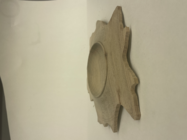Hi.
Before I re-embark on the process of re-learning some turning skills that have been unused way too long I have a rather simple question. Let me start by saying I have been away from turning for the better part of 25 years - long story, but primarily day job got in the way! Back then the few bowls I turned were done with faceplates as that was the technology I was familiar with and possessed. That said, times have changed and it's time to embrace some different technology - hopefully easier and better. The bowl blanks I have are small, approx. 6 inches in diameter and 1-1/2 inches thick - big enough for a couple of small, shallow bowls for practice. Because of the thin material I will use a faceplate and glue block on what will be the top of the bowl and turn the bottom/sides to finish and create a recess for #2 smooth dovetail jaws (Oneway Talon chuck) to turn the top and inside. My question is how deep to turn the dovetail recess for the jaws? The dovetail portion on the jaws appears to be about 1/4 inch, so is this the right depth for the recess or should it be more? Less? How critical is the depth - is there a rule of thumb for depth vs bowl size? How does my procedure sound overall? I guess this ended up being more than one question! Any and all advice is appreciated. Thanks in advance.
Barry W. Larson
Calgary, Alberta, Canada eh!
Before I re-embark on the process of re-learning some turning skills that have been unused way too long I have a rather simple question. Let me start by saying I have been away from turning for the better part of 25 years - long story, but primarily day job got in the way! Back then the few bowls I turned were done with faceplates as that was the technology I was familiar with and possessed. That said, times have changed and it's time to embrace some different technology - hopefully easier and better. The bowl blanks I have are small, approx. 6 inches in diameter and 1-1/2 inches thick - big enough for a couple of small, shallow bowls for practice. Because of the thin material I will use a faceplate and glue block on what will be the top of the bowl and turn the bottom/sides to finish and create a recess for #2 smooth dovetail jaws (Oneway Talon chuck) to turn the top and inside. My question is how deep to turn the dovetail recess for the jaws? The dovetail portion on the jaws appears to be about 1/4 inch, so is this the right depth for the recess or should it be more? Less? How critical is the depth - is there a rule of thumb for depth vs bowl size? How does my procedure sound overall? I guess this ended up being more than one question! Any and all advice is appreciated. Thanks in advance.
Barry W. Larson
Calgary, Alberta, Canada eh!

